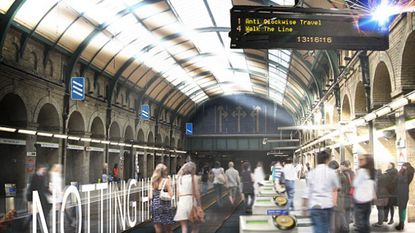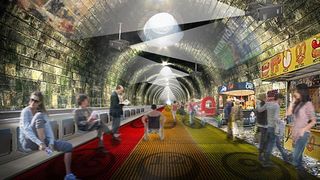Replace Tube trains with travelators, say architects
Conceptual plan turns Circle Line into a 17-mile-long moving walkway, offering three different speeds

An architecture firm has unveiled a conceptual plan to turn London Underground's much-maligned Circle Line into a 17-mile-long moving walkway.
The idea, from architects NBBJ, consists of replacing all of the trains on the route with a set of three travelators. Each walkway would move at a different speed, ranging from 3mph to 15mph.
"The result would be considerably quicker, more enjoyable and healthier journeys," NBBJ said in a statement. It added that the Circle Line travelator would "likely become one of London's most efficient and unusual modes of transport".
Subscribe to The Week
Escape your echo chamber. Get the facts behind the news, plus analysis from multiple perspectives.

Sign up for The Week's Free Newsletters
From our morning news briefing to a weekly Good News Newsletter, get the best of The Week delivered directly to your inbox.
From our morning news briefing to a weekly Good News Newsletter, get the best of The Week delivered directly to your inbox.
The architecture firm has so far only released a series of images depicting the concept. However, critics have already suggested that there may be some underlying issues.

Gizmag highlights one such issue, explaining: "While moving walkways are used by a large number of travellers in airports worldwide, being required to navigate such a system would no doubt prove tricky for the elderly and some disabled people."
According to The Independent, the NBBJ project is more like the "trottoir roulant rapide" that opened at Montparnasse station in Paris in 2002. Although it was initially a success, it had to be slowed down from 6mph to 3mph after passengers were repeatedly injured trying to get off the faster part of the walkway.[[{"type":"media","view_mode":"content_original","fid":"84344","attributes":{"class":"media-image"}}]]
Commentators have pointed out the similarities between NBBJ's idea and Caves of Steel, a novel by famous science-fiction writer Isaac Asimov.
In Asimov's work, "caves of steel" – vast city complexes covered by huge metal domes, where commuters transit on moving travelators between malls and their homes – are constructed to counter over-population.
Daily Mail notes that in the book no one ever leaves the domes, and most of the population suffers from extreme agoraphobia.
This is not the first ground-breaking idea for London that the architecture firm has produced. In March, NBBJ developed proposals for two twisting towers in North Greenwich, London, that would bounce light between them down to a public space that would otherwise be in their shadow.
"We like to push the boundaries of what is achievable with design computation by developing new applications like the No Shadow Tower," the firm said.
Create an account with the same email registered to your subscription to unlock access.
Sign up for Today's Best Articles in your inbox
A free daily email with the biggest news stories of the day – and the best features from TheWeek.com
-
 The new powers to stop stalking in the UK
The new powers to stop stalking in the UKThe Explainer Updated guidance could help protect more victims, but public is losing trust in police and battered criminal justice system
By Harriet Marsden, The Week UK Published
-
 'Criminal trail?'
'Criminal trail?'Today's Newspapers A roundup of the headlines from the US front pages
By The Week Staff Published
-
 Grindr 'shared user HIV status' with ad firms, lawsuit claims
Grindr 'shared user HIV status' with ad firms, lawsuit claimsSpeed Read LGBTQ dating app accused of breaching UK data protection laws in case filed at London's High Court
By Rebecca Messina, The Week UK Published
-
 Why the Metro Memory game is so addictive
Why the Metro Memory game is so addictiveTalking Point Trying to remember London's 416 Tube stops has attracted half a million players so far
By Sorcha Bradley, The Week UK Published
-
 How cybercriminals are hacking into the heart of the US economy
How cybercriminals are hacking into the heart of the US economySpeed Read Ransomware attacks have become a global epidemic, with more than $18.6bn paid in ransoms in 2020
By The Week Staff Last updated
-
 Language-learning apps speak the right lingo for UK subscribers
Language-learning apps speak the right lingo for UK subscribersSpeed Read Locked-down Brits turn to online lessons as a new hobby and way to upskill
By Mike Starling Published
-
 Brexit-hobbled Britain ‘still tech powerhouse of Europe’
Brexit-hobbled Britain ‘still tech powerhouse of Europe’Speed Read New research shows that UK start-ups have won more funding than France and Germany combined over past year
By Mike Starling Published
-
 Playing Cupid during Covid: Tinder reveals Britain’s top chat-up lines of the year
Playing Cupid during Covid: Tinder reveals Britain’s top chat-up lines of the yearSpeed Read Prince Harry, Meghan Markle and Dominic Cummings among most talked-about celebs on the dating app
By Joe Evans Last updated
-
 Brits sending one less email a day would cut carbon emissions by 16,000 tonnes
Brits sending one less email a day would cut carbon emissions by 16,000 tonnesSpeed Read UK research suggests unnecessary online chatter increases climate change
By Joe Evans Published
-
 Reach for the Moon: Nokia and Nasa to build 4G lunar network
Reach for the Moon: Nokia and Nasa to build 4G lunar networkSpeed Read Deal is part of the US space agency’s plan to establish human settlements on the lunar surface
By Mike Starling Last updated
-
 iPhone 12 launch: what we learned from the Apple ‘Hi, Speed’ event
iPhone 12 launch: what we learned from the Apple ‘Hi, Speed’ eventSpeed Read Tech giant unveils new 5G smartphone line-up
By Mike Starling Last updated